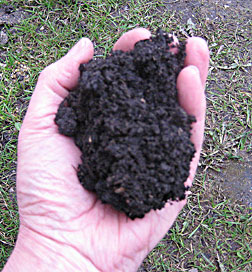Types of Soil
Basic Soil Structure
Soil consists of particles of rock and minerals combined with organic matter and this composition can vary quite widely according to the geology of the area and the way the soil has been worked over the years.
Each type of soil has different characteristics when it comes to retaining water, air and nutrients and when releasing these life giving ingredients to the plants.
It is because the characteristics vary so much that it is important to know the type of soil you are working with if you hope to get the best results from your garden.
Whatever type of soil you have, it can be improved by the addition of organic matter. This can be obtained from a variety of sources such as spent mushroom compost, old grow-bags, farmyard manure (if you can withstand the typical ‘country’ odour), the local council’s recycled compost or, best of all, your own compost heap.
Main Soil Types

Gardeners refer to the following types of soil:
- Clay
The most common type of soil around the UK and many other places for that matter. The main difficulty with a clay soil is that it holds water so drainage suffers, but in lengthy hot, dry periods it can become baked hard. However, in spite of these negatives, it can still be the most productive for the gardener.
To improve the texture of clay soil and to help with drainage, you need to add organic matter. A lime dressing can help break down the soil and if it is particularly heavy, you may need to add sand, which is available from your local builders' merchant. - Silt
This kind of soil, which originated from river deposits, consists of very fine particles. It is really versatile when it comes to growing a wide range of plants.
Although drainage can be a problem with silty soils, they rarely become waterlogged.
It is worth using a soil testing kit to establish the alkalinity/acidity of the soil so you are able to select the plants that will thrive best. - Sand
This type of soil is easily recognised since it has the feel and colour of sand.
It tends to be much freer draining and not to hold water, which can be a problem in a dry climate when it is necessary to water and feed plants on a frequent basis.
Adding plenty of organic matter can help improve the texture and water retention.
Sand tends to warm up faster than other types of soil and therefore it is usually possible to plant seeds and young plants earlier in the year. - Chalk
By its very nature, this is a predominantly alkaline soil and is therefore unsuitable for acid loving plants such as rhododendrons and azaleas.
Chalk is also free draining – a condition that can be improved by the addition of plenty organic matter.
If you want to grow acid loving plants but prefer not to use containers, the condition of the soil can be altered by adding sedge peat or even flowers of sulphur. However, this will need to be an annual task to maintain an appropriate pH balance. - Peat
This type of soil tends to be more acidic than most other soil types and therefore acid loving plants thrive in it.
Some of the best farmland in the UK has this kind of soil, which feels spongy to the touch and is very easy to work. - Loam
Considered by many to be the ultimate soil for gardeners. It is rich in nutrients and easy to work.
Apart from the natural texture, it has invariably gained some of its characteristics from having been well cultivated over the years by a gardener or allotment holder.
Because of these characteristics, it is able to grow a very wide range of plants.
Read more about Types of Soil |
Read more about Soil and Climate |
